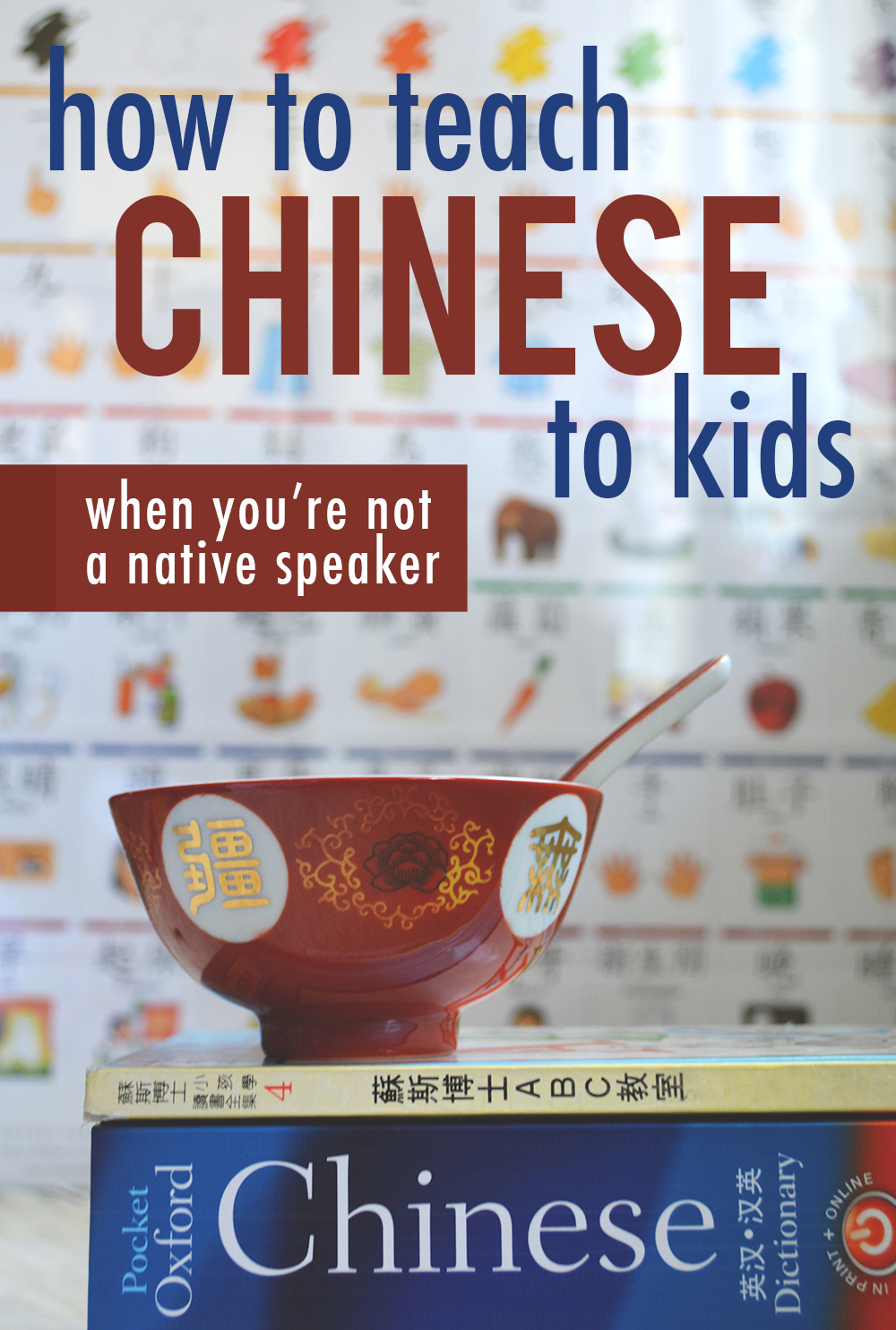
I’m not an expert. I didn’t grow up speaking Chinese. But if you’ve followed @oaxacaborn on Instagram or @oaxacaborn on YouTube for any length of time, you’ve heard my daughter speak Chinese. This little fact delights some people, and perplexes others. Now, if you know Aveline, you know that she talks to everyone. EVERYONE, everywhere. Most people, when they hear her speaking Chinese, look bewildered and then quickly look away in confusion. After all, it is completely out of context for a little blonde girl to be reciting traditional Chinese poems down the aisles of Target in the suburbs.
[We are a participant in the Amazon Services LLC Associates Program, an affiliate advertising program designed to provide a means for us to earn fees by linking to Amazon.com and affiliated sites.
As an Amazon Associate I earn from qualifying purchases.]
Why Chinese?
Other people, though ask questions — a lot of questions. Many are just curious, “Why Chinese?” You’ve heard the old joke, right?
“What do you call a person who knows three languages?”
“Trilingual.”
“What do you call a person who knows two languages?”
“Bilingual.”
“What do you call a person who knows one language?”
“American.”
But I’m not one to talk, since I lost both Spanish and Slovene to the cobwebbed recesses of my brain. So I usually just say, “Why not? Most people around the world learn more than one language, and ~1 billion people speak Mandarin [1]. Only about 480 million people speak English.”
The truth is, while the characters seem intimidating, Chinese grammar is simple when compared to English’s complexities. For the most part, basic Chinese doesn’t concern itself too much with tenses, plurals, the gender of nouns, or articles like a, an, the. There are exceptions to this, of course, but the bottom line is that you can learn Chinese without spending hours pouring over verb conjugations they way you would in, say, French or Spanish. Yes, it’s a tonal language, so the tones are challenging, but children are much better are differentiating pitch than adults — and the earlier a child begins learning Chinese tones, the better. (Here’s a slightly off-topic study on pitch, musical ability, and early language development. But I digress.)
Another question many curious people ask is, “How do you get her to learn Chinese?”
Well, if you have figured out a way to get a human being — much less a four-year-old — to do anything, let me know, because you sure aren’t going to find the answer here. But I can share the resources we use that make the process fun!
Learning Chinese Through YouTube Videos
YouTube is just overflowing with language tutorials, and videos of native speakers demonstrating how to properly pronounce the words and phrases. And it’s free! YouTube is where it all started, actually. I was trying to find something fun and different for Aveline to engage her brain. She was three, begging to ‘do school’ and ‘have worksheets’ on an almost-hourly basis, and I was going through [English] preschool workbooks like there was no tomorrow. I really didn’t have some grand, well-thought-out plan to begin Mandarin instruction, I was just trying to get through the afternoon. (True confessions.) She was hooked after just one kids’ video in Mandarin. After that, it took going through several different Mandarin instructional channels before I found a teacher she really connected with, but once we found our favorite teacher, it was amazing how quickly she began speaking Chinese. I can’t recommend Emma form Learn Chinese With Emma highly enough. Our first video? Learning to count from 1-10 in Mandarin Chinese, seen above. Bonus? Learn the numbers, and you’ve learned the tones, without even realizing it.
Flashcards, Audio CDs, and Reference Charts
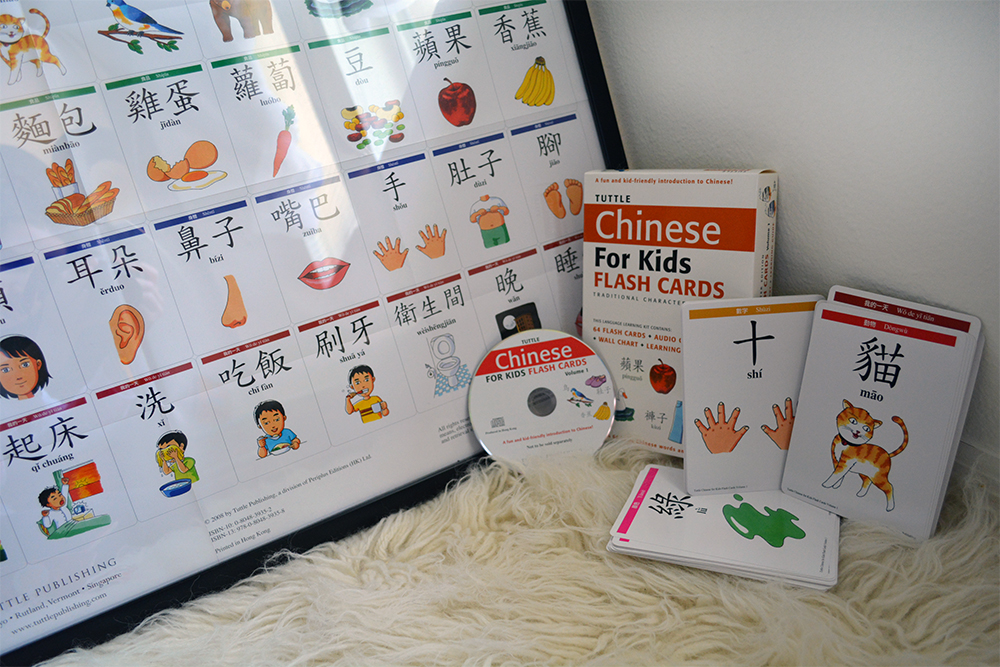
If you ask me, there’s only one solid resource in this category, Tuttle Chinese for Kids: Flash Cards Kit Vol 1! It’s just that good. This set comes with sixty-four beautifully illustrated, sturdy flashcards, an audio CD with all the vocabulary words in context, as well as a separate 24×36″ poster which shows the front side of all flashcards. We keep the poster out in the living room at all times, at kid-height, and our daughter consults it constantly. I really believe a big part of success in language learning is to make it a part of everyday life, rather than segmenting it off into a separate “learning” time. Isn’t that true with anything, though?
The CD is very well done. Each track was recorded at a relaxed pace, with pauses in just right places, so the child (and you!) can repeat back what’s said. Because this kit is designed for children, it’s a refreshing change from the stale “Where is the airport?” and “Can you exchange this currency?” phrases taught in so many (dull) language programs for adults. All sixty-four vocabulary words are included in the CD, as well as a couple of sentences for each, so each word can be learned in context as well. The sentences are spoken in Chinese as well as in English — and some of the sentences are even included on the back of the corresponding flashcards. For those interested in the proper stroke order to write the characters, that’s diagrammed on the flashcard back, too.
(With this, as with all our Chinese language resources, we’ve chosen the Traditional Character edition, which teaches the characters used in places outside mainland China, such as Taiwan. If you want to learn Simplified Characters instead, then you’ll want the Tuttle Chinese for Kids: Flash Cards Kit Vol 1: Simplified Character Edition.)
My daughter is in Chinese school — more about that later in this post — and I noticed that the content covered in this set was very on-track with the content covered in the first semester of her class. This week, since we’re already well into the second semester, I ordered the sequel set, Tuttle More Chinese for Kids: Flash Cards. These sets have turned me into something of a Tuttle fangirl, actually. Tuttle is a speciality publishing house focusing all Asian language, culture and history, and I’ve discovered it’s a terrific place to order books about Chinese, Japanese, Korean, and other Asian cultures. I guess I can wave zài jiàn 再見 to that money I’d stashed away for a rainy day!
Coloring and Activity Books for Chinese Education: Dover Books

Dover Books is another great resource for inexpensive, yet impressively detailed, consumable books. The coloring books, like the Chinese Fashions and Mandarin Picture Word Book titles shown here, have intricate black and white line drawings and historically/linguistically accurate captions. No, it’s not a Chinese language curriculum, but it’s such a fun — and cheap! — way to supplement cultural education. The various Dover Chinese Paper Dolls are great too!
Coloring and Activity Books for Chinese Education: Practical Chinese Series
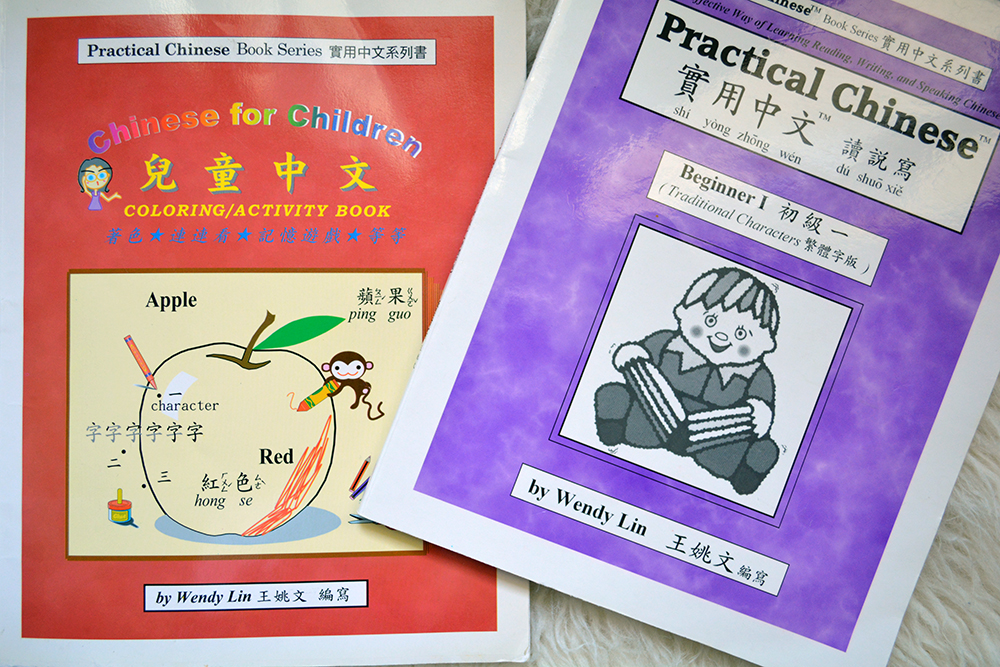
The way Wendy Lin’s Practical Chinese Book Series is titled is a little confusing — at least, it was for me. I ordered Practical Chinese: Traditional Characters for Beginners I at first, but then realized what I really wanted was the first book, Chinese for Children,
which is the red coloring/activity book pictured on the left. There’s no bells or whistles here, and the illustrations certainly aren’t high-quality, but the workbook lets very young children begin familiarizing themselves with with Chinese characters through basic coloring pages, matching exercises, and other similar activities. The book covers body parts, names of clothes, colors, fruits, numbers, and a few adjectives like “big” and “small”. I wouldn’t really call it curriculum, but it’s a good cursory, hands-on introduction for a young, interested, child. (If you’re learning Simplified Characters rather than traditional, then you’ll want Chinese for Children, Simplified Character Edition
.)
Chinese Phonetics [Pinyin] and Learning to Read and Write Chinese Characters
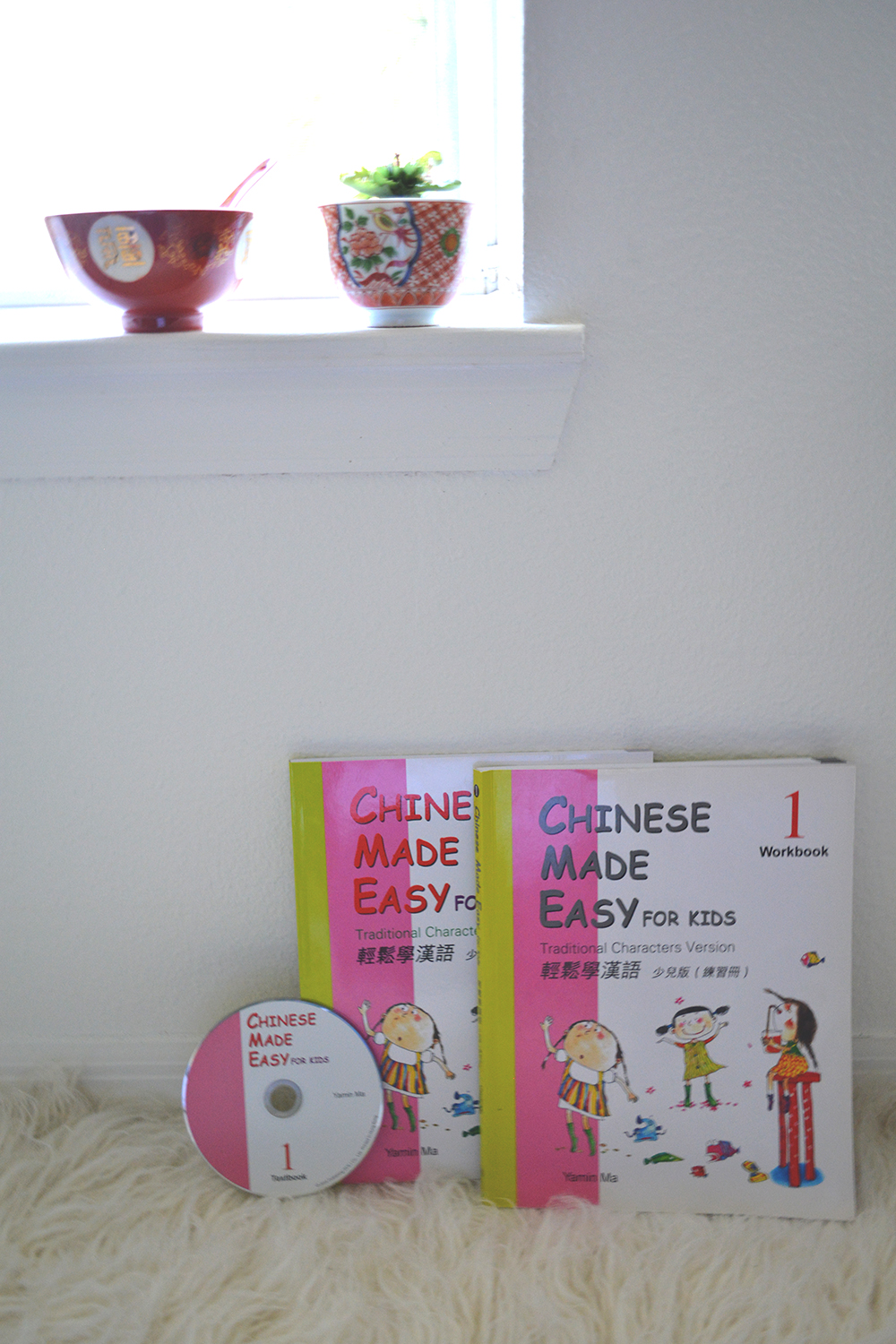
We started out with mostly spoken Chinese, but now we’re moving on to learning to read and write Chinese characters, since Aveline has expressed a great deal of interest in that. (Ok, fine, my strange child is begging.) And for reading and writing, I LOVE the Chinese Made Easy for Kids Textbook 1 with CD and the accompanying Chinese Made Easy Workbook 1, which also dives into Chinese pinyin. I think the phonetics aspect might be overwhelming if it was someone’s very first introduction to any kind of Chinese, spoken or written — but already being familiar with spoken Chinese, seeing the pinyin and learning to match them to the tones given on the CD hasn’t actually been very daunting. These books are fun — colorful, energetic, and designed to really motivate and give the child a sense of great accomplishment. They’re early elementary, but could definitely be used for someone older who wanted to start out as well — I’m doing them alongside my daughter. Again, we’re doing the traditional edition, so if you want Simplified Characters instead, you’ll want the Chinese Made Easy for Kids, Simplified Chinese Edition Textbook 1
and Workbook 1.
Your Local Chinese Cultural Center
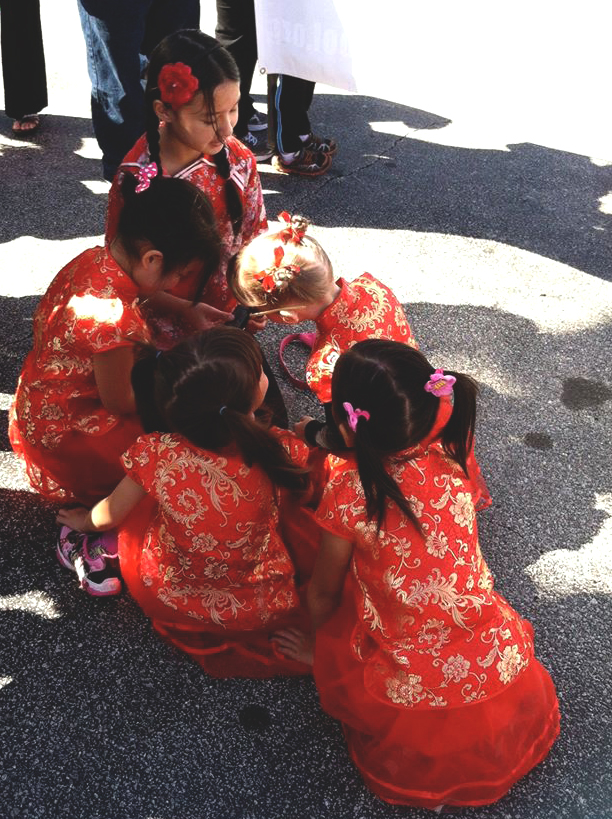
Many areas have an active Chinese-American community association, dedicating to teaching Chinese language, culture, and traditions. Don’t overlook this — it’s is an incredible resource! Through our local cultural center, my daughter not only attends language and folk dance classes each week, but she’s also participated in Chinese festivals like the Mid-Autumn Moon Festival, gotten to watch traditional Chinese opera, lion dance, kung fu and musical showcases, and even performed a Chinese folk dance performance with her classmates at the big local Lunar New Year parade and festival. It’s a terrific, welcoming community, and she (and I!) are able to practice speaking Chinese with native speakers on a regular basis.
Where to Buy Bilingual-Chinese Books, VCDs and More
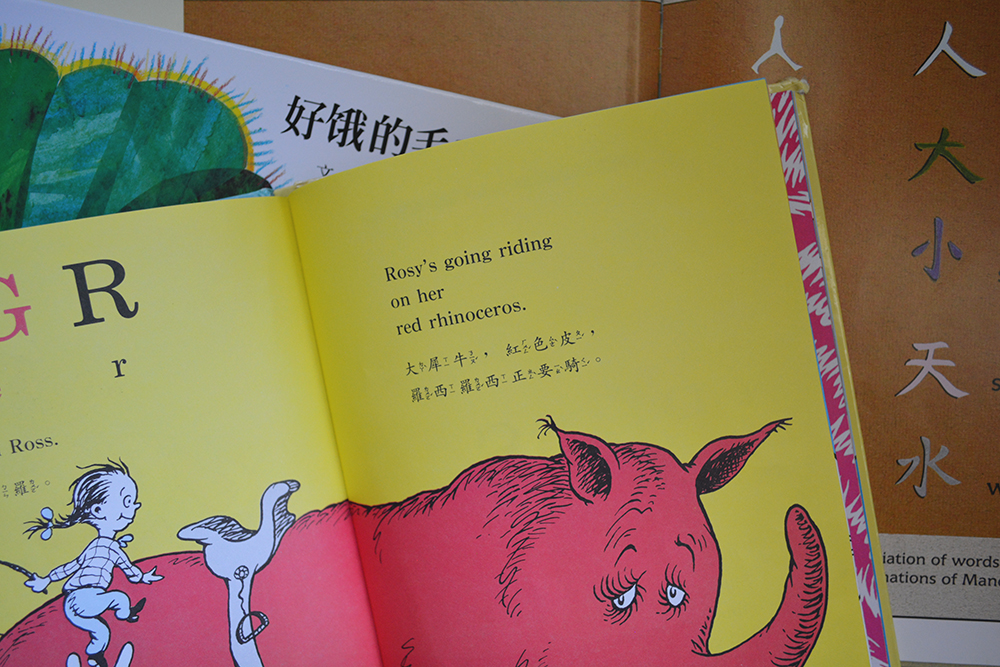
We love to have bilingual and Chinese books around the house, too, to keep the Chinese flowing between classes or workbook sessions. A few places I’ve found to order Chinese books, puzzles, and VCDs (video CDs that get around that pesky DVD region issue) are China Sprout (the site is split into Cultural and Education categories), Language Lizard, Asian Parent, and the Happy Panda Shop.
Where to Listen to Chinese Books and Songs
Like I mentioned before, YouTube is a fantastic, often overlooked treasure trove for language education. On YouTube, you can listen to native speakers reading children’s books in Chinese, or set up a playlist of popular Chinese children’s songs, like the one above. And when you’re ready to search for music videos or other content entirely in Chinese? Head over to Youku (pronounced yo-ku).
Don’t be afraid to begin learning Chinese! To quote a Lao Tzu cliché: “The journey of a thousand miles begins with a single step.” And, today’s internet makes the world so much smaller when it comes to venturing out on a journey like this. There are SO many resources available.
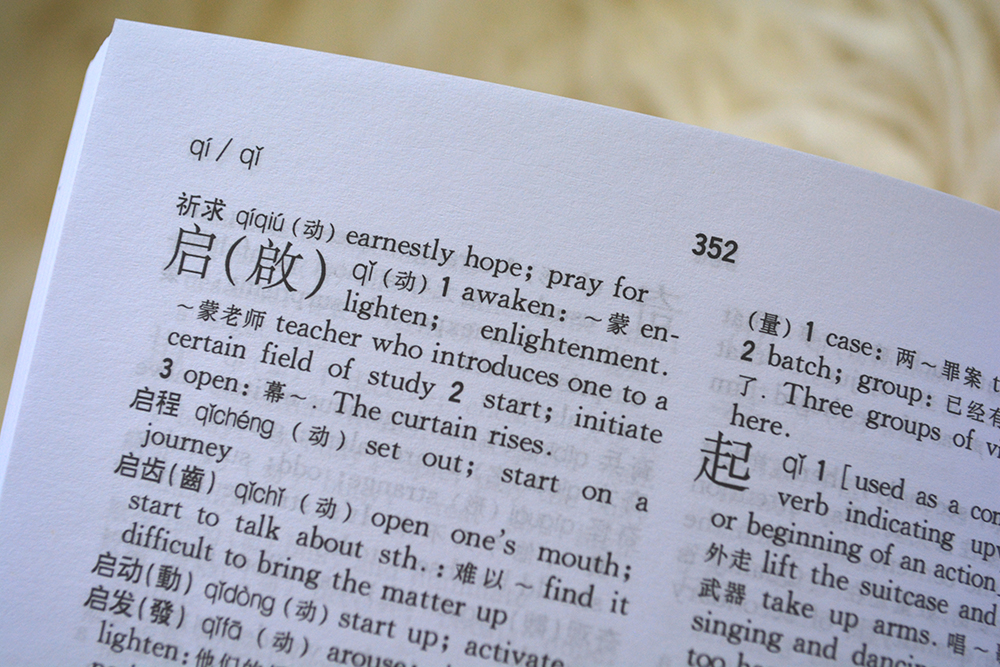
If you have questions, please leave them in the comments and I’ll do my best to answer! And if you found this helpful, why not click here to get this post’s Permalink, then pin it to Pinterest? :)
We are a participant in the Amazon Services LLC Associates Program, an affiliate advertising program designed to provide a means for us to earn fees by linking to Amazon.com and affiliated sites.
This post also participated, without compensation, in a Friday Favorites link-up on HipHomeschoolingBlog.com.



This is fascinating! If your daughter continues to learn and speak and eventually write Chinese, she will be so far better prepared for the world of the future than her peers. Congratulations on your foresight!
LikeLike
Wow! This is so impressive! Cheers to you for exploring all of these resources to provide your daughter with a fun educational activity that will benefit her throughout her life. This is a very detailed post. I wish I was learning Chinese now!
LikeLike
I may use some of these resources to relearn some the Chinese I knew as a child. Kudos to you for expanding her world like this!
LikeLike
SO COOL! My sister and I just learned to count to 10!
LikeLike
Two of my daughters are Chinese, and they’re downstairs watching Winnie The Pooh in Mandarin from our local library right now. :) I’m hoping to get them into Chinese school in the fall.
LikeLike
I LOVE this!! :)
LikeLike
This is such a great post! I pinned two of your images! We teach Spanish to our kids, this is the time to teach them! They retain so much and their mind is essentially “unlocked” to languages. I think Chinese is an awesome idea, it will serve her so well!
Thanks for sharing and linking up at Favorite things Friday! Hope to see you again this week!
LikeLike
You are awesome! I know learning Chinese is so important, and I’m glad I know both (or three, included my Cantonese). Besides that, I’m currently homeschooling my two young girls at home. I created my own pre-school lesson plans and curriculum in Eng and Chinese. And I’m starting to create some Pre K/ Kindergarten Chinese Packs and learning materials. I’ve got English & Chinese version, only Chinese, and Chinese & PinYing. If you are interested, welcome to go to my website. Hope it can help you and your girl. Btw, she is so cute.
LikeLike
Such a great post! I will definitely consider these techniques as I try and get my twins into Mandarin. They currently loveeeee watching Peppa Pig so when I can, I try and put the Mandarin version up for them to watch so they can get used to the sounds. As I am also re-learning the language, practicing with the kids I see being super helpful. And i definitely want to look at Mandarin classes for them to go to!
LikeLike
Hi, loved this post! Just interested to hear where you got the nursery rhyme book with pinyin? We also got the tuttle flashcards and my daughter loves the cards and poster, but struggling to tolerate the CD (which I need!), just wondering how you used the CD? My daughter has just turned 3.
LikeLike
Thanks for sharing! My children are also learning Chinese but they started through an Immersion Preschool and now we are trying to keep up with a couple classes a week. I’ve been thinking about supplementing myself, but since I don’t know Chinese it’s been super intimidating! I’m going to check out some of these YouTube resources, thanks!
LikeLike
I just re-read this post again after I first visited here. I like the resources that you recommend and I like how you keep it simple with language learning. Your top-down approach to the Chinese language gives a great analysis and break the myth behind “one of the most difficult languages.” Furthermore, not speaking the language is not an obstacle but a way to gather great resources and make it happen. Thank you for sharing this.
LikeLike
Thanks for your post! Our kids are actually going to full immersion Chinese kindergarten and are doing amazing well! Here is a video after just 1 year of attending https://www.youtube.com/watch?v=WkKupZijK3c Since I am NOT a native Chinese speaker I actually think it would be detrimental to do flash cards etc (because my accent is rubbish), so I was looking for some links and recommendations to youtube channel. Thanks for sharing!
LikeLike
Thank you so much for sharing these resources! I too am teaching my little one Chinese while learning myself. What made you decide to go with traditional characters instead of simplified? Mahalo!
LikeLike
great post! just happened upon it via pinterest! Didn’t realize you’re learning Chinese with your daughter!
LikeLike
What a great compilation of resources for helping parents teach their kids Chinese! Even though this is an older post, your approach still applies today, such as using fun videos, activity books, visual aids to create an immersive Chinese learning environment. Thank you for sharing your Chinese learning journey with your daughter!
LikeLike